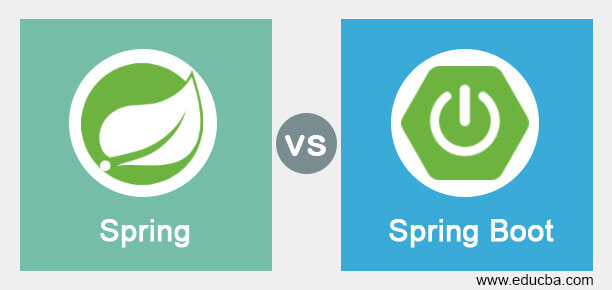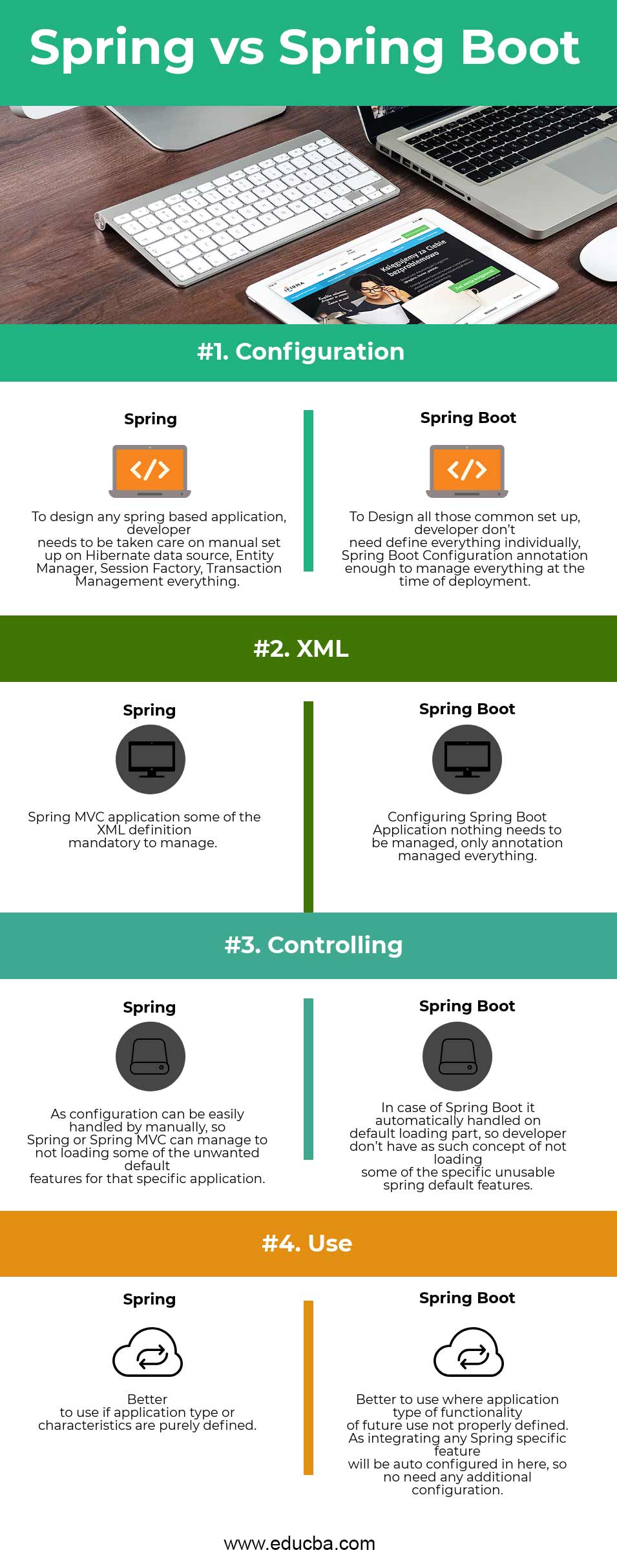Updated June 22, 2023
Differences Between Spring vs. Spring Boot
The Spring Framework is one of the most popular frameworks which helps application development in Java. It maintained various ways of object or beans relationship. It is beneficial for dependency injection (DI) or Inversion of Control (IOC), which wonderfully helped us develop loosely coupled applications, which automatically helped proper unit testing of any Java application.
There have many other features, including the Spring Framework, which is also very popular in any constant. Those features can be divided into almost twenty modules that help resolve many problems, which are surprisingly very common in any java application. Some popular modules are explained below:
- Spring JDBC
- Spring MVC
- Spring AOP
- Spring ORM
- Spring JMS
- Spring Test
- Spring Expression Language (SPEL)
Spring JDBC is one of the prevalent features of spring application. We can use the spring default JDBC framework whenever we want to fetch data from any RDBMS database.
Spring MVC denotes model, view, and controller design pattern, mainly used for developing web applications using spring.
Aspect-Oriented Program (AOP) is mainly used for any aspect like security or logging integration with any Java application, unique features of it, and this feature can be called before or after a method call after a method return or exception arises in the application. Spring can be easily integrated with any ORM tool. Spring tests for testing purposes and expression language are used for view presentation.
Spring boot is based on all the default features of spring. Core Spring and MVC can handle the required elements of any Java application. As per complexity and configuration, spring boot can help us significantly reduce spring configuration-related complexity.
Head-to-Head Comparison Between Spring vs. Spring Boot
Below is the top 4 difference between Spring vs. Spring Boot
Critical Differences Between Spring vs. Spring Boot
Both Spring vs. Spring Boot are popular choices in the market; let us discuss some of the significant Difference Between Spring and Spring Boot.
- Spring mainly concentrates on its core and MVC features, where a developer needs to manually configure and define which feature needs to be used by the application as per requirement. At the same time, Spring Boot automatically loaded all the features of spring core and MVC. The developer does not need to define any specific configuration manually.
- Spring core has multiple modules that can be used for different purposes and resolve some standard utilities per java application requirements. Modules like Spring JDBC, MVC, AOP, ORM, etc., are helpful for any aspect per project requirements. All those utilities can be appropriately configured and utilized per system or project requirements. Whereas Spring Boot can easily use all those requirements by defining the application as @SpringBootConfiguration, that annotation is enough to manage to load the entire spring configuration or all the modules features based on the jar files or dependency mentioned for that specific spring boot project.
- Transaction management is one of the most critical jobs in any Spring applied; then, the developer has to define a proper transactional management key for every hibernate session or DB connection (in the case of Spring JDBC), spring a specific transactional class needs to be defined in the application-specific configuration file for using those in the entire application which can manage the transaction properly. Whereas Spring Boot automatically contains fundamental transactional data without mentioning any specific configuration manually, the whole thing can be handled automatically. Marketing can be defined in every session or connection opening and closing. A transaction can be committed or rollback based on the entire task of that specific session completion status.
- Integration with any ORM tool is critical for any spring application. It needs to define its data source properly in the configuration file manually by the developer, and there have changes that need to be done for any ORM tool exchange. In the case of spring, the boot can be accessible to auto-configured, with no need for manual intervention; only defining one database property file is enough for the entire setup.
- Spring core or Spring MVC structure developer can easily maintain on loading only require feature based on project requirement. Whereas in the case of spring boot, all the attributes defined in dependency or jar files will be automatically loaded, a developer cannot deploy any specific feature based on project requirements.
Spring vs. Spring Boot Comparison Table
The primary Comparison between Spring vs. Spring Boot is discussed below:
| The basis of comparison Between Spring vs. Spring Boot |
Spring |
Spring Boot |
| Configuration | To design any spring-based application, a developer must take care of manual setup on Hibernate data source, Entity Manager, Session Factory, and Transaction Management. | To Design all those standard setups, a developer doesn’t need to define everything individually; SpringBootConfiguration annotation is enough to manage everything at the time of deployment. |
| XML | In Spring MVC applications, some of the XML definitions are mandatory to manage. | Configuring Spring Boot Application, nothing needs to be managed; the only annotation contains everything. |
| Controlling | As configuration can be easily handled manually, Spring or Spring MVC can manage to not load some of the unwanted default features for that specific application. | In the case of Spring Boot, it is automatically handled on the default loading part, so the developer doesn’t have the concept of not loading some of the specific unusable spring default features. |
| Use | Better to use if application type or characteristics are purely defined. | Better to use where the application type of functionality for future use is not defined correctly. Integrating any Spring-specific feature will be auto-configured here, so there is no need for additional configuration. |
Conclusion – Spring vs. Spring Boot
Spring vs. Spring Boot is a general framework for Java/J2EE applications at any time. Typically, the developer will choose which framework will be better to use based on the application requirement or functionality. Suppose the application has some possibility of using verities Spring modules in any circumstances on future integration; in that case, Spring boot will always be a better option because just adding the required dependency or jar file is enough to use that specific module integration with your existing application. But if an application doesn’t have that kind of prospect or plans to only make a pure web application, in that case, Spring MVC will be a good approach, as a developer have a lot of control over the features enabled or disabled.
Recommended Article
This has guided the top difference between Spring and Spring Boot. Here we also discuss the Spring vs. Spring Boot critical differences with infographics and a comparison table. You may also have a look at the following Spring vs. Spring Boot articles to learn more –




